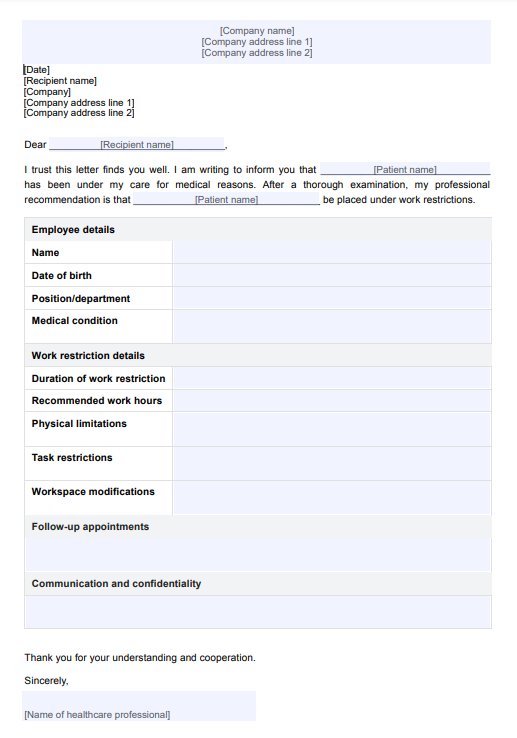Request a work restriction letter during your medical appointment by explaining your current job tasks and any difficulties you're experiencing due to your medical condition. Bring a written job description if available, and be specific about physical demands like heavy lifting, extended periods of standing, or exposure to extreme temperatures. Your healthcare provider will evaluate your medical treatment progress and the nature of your work-related injury or illness to determine appropriate restrictions.

Work Restriction Letter from Doctor
Use our free Work Restriction Letter from Doctor template to advocate for reasonable accommodations in line with the employee's limitations.
Work Restriction Letter from Doctor Template
Commonly asked questions
The cost of a doctor's letter, often referred to as a medical certificate or note, is highly variable and generally not covered by health insurance, as it is an administrative service rather than a medical treatment. The fee, if any, is set by the individual practice or healthcare system and can range from being provided for free (especially for simple, immediate sick notes) to a significant charge (e.g., $15 to $100 or more) for more detailed reports, completion of extensive forms for disability or extended leave, or letters required long after a visit.
A leave restriction letter is an official document, typically issued by an employer to an employee, which imposes strict conditions on the employee's future use of sick leave due to a pattern of what the employer considers sick leave abuse or excessive unscheduled absences. While not a form of discipline itself, the letter often requires the employee to provide an acceptable medical certificate from a healthcare provider for every subsequent absence, regardless of duration, and outlines the consequences (which may include disciplinary action) if the pattern of abuse or failure to provide documentation continues.
EHR and practice management software
Get started for free
*No credit card required
Free
$0/usd
Unlimited clients
Telehealth
1GB of storage
Client portal text
Automated billing and online payments











